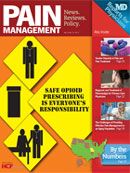Institute of Medicine Report Offers a Snapshot of the Challenges Associated with Providing Effective Pain Management to an Aging Population
The recently released Institute of Medicine report Relieving Pain in America: A Blueprint for Transforming Prevention, Care, Education, and Research touched on several key issues in pain management in the geriatric population.
The Institute of Medicine (IOM) report revealed that providing pain care to elderly patients places a substantial financial burden on health care expenditures in the US. According to the report, “the annual economic cost of chronic pain in the United States is at least $560—635 billion. This estimate combines the incremental cost of health care ($261–300 billion) and the cost of lost productivity ($297–336 billion) attributable to pain.” The Medicare program “bears fully one-fourth of US medical expenditures for pain; in 2008, this amounted to at least $65.3 billion, or 14% of all Medicare costs.” This cost can be expected to increase in the coming years as the proportion of Americans over the age of 65 increases.
The aging of the US population means that “a growing number of Americans will experience the diseases with which chronic pain is associated—diabetes, cardiovascular disorders, arthritis, and cancer, among others.” Currently, a substantial percentage of elderly patients may be suffering with pain. In fact, the IOM report states that most researchers who use a definition of chronic pain similar to “persistent or recurrent pain for at least 3-6 months” have found chronic pain in “about half of elderly individuals surveyed.” Patients in nursing homes may experience an even higher prevalence of pain; on study found that 62% of US nursing home residents reported that they regularly experienced pain, with more than 17% of this group reporting “substantial daily pain.”
Barriers to treatment
The barriers to effective pain management for not just the elderly population but for all patients suffering with pain exist at multiple levels:
- The system level, where “changes are needed in reimbursement policy and research emphasis”
- The clinician level, where “improvements are needed in clinical education and practice”
- The level of the public and the individual person in pain, where “greater awareness is needed of the significance of pain, as is more education about self-management and appropriate treatment”
According to the authors, overcoming these barriers to improved pain care will require “a cultural transformation” that must lead to “a greater awareness of the impact of pain on individuals and society, wider support of efforts to understand and prevent pain, a greater commitment to assessing and treating pain effectively, and enhanced recognition of the highly individual ways in which people experience pain and respond to treatment.”
Barriers to effective pain management specific to the geriatric population include the “documented undertreatment of pain in the elderly,” the “lack of an evidence base concerning the pharmacokinetic and pharmacodynamic changes that occur with aging,” and the fact that “elderly people rarely are included in clinical trials of medications, so clinicians have inadequate information about appropriate dosages and potential interactions with medications being taken for other chronic diseases.” Also, given that patient self-report of symptoms and pain severity is the “gold standard” for measuring pain, the fact that nearly one-third of nursing home residents in the US have a mental disorder or other serious condition associated with dementia or other cognitive impairments that might interfere with self-reports of pain represents “a substantial barrier to pain assessment and management.”
Broad-stroke recommendations for improvement
Throughout the IOM report, the authors recognize the importance of primary care physicians in the provision of effective, patient-centered pain management to elderly patients, noting that the majority of care and management “should take place through self-management and primary care, with specialty services being focused on recalcitrant or more complex cases. Accordingly, individualization of pain management is necessary throughout the health care system. Health care providers need to foster pain care that is patient-centered and, when necessary, comprehensive and interdisciplinary.”
Although the authors noted that people with pain “should be encouraged to engage in ‘self-management,’” they cautioned that patients “should not be burdened with the impression that failing to control the pain is somehow their fault or responsibility.” They wrote that it is possible that “more intense and focused attention to the individual, similar to care management or disease management, could point the way out of this dilemma. People who present frequently for pain care and receive many different treatments might, like other frequent users of health care, benefit from a strong commitment by a team or practitioner focused on comprehensive care, rehabilitation, and increased functioning.”
